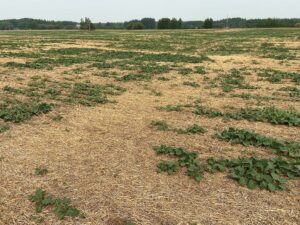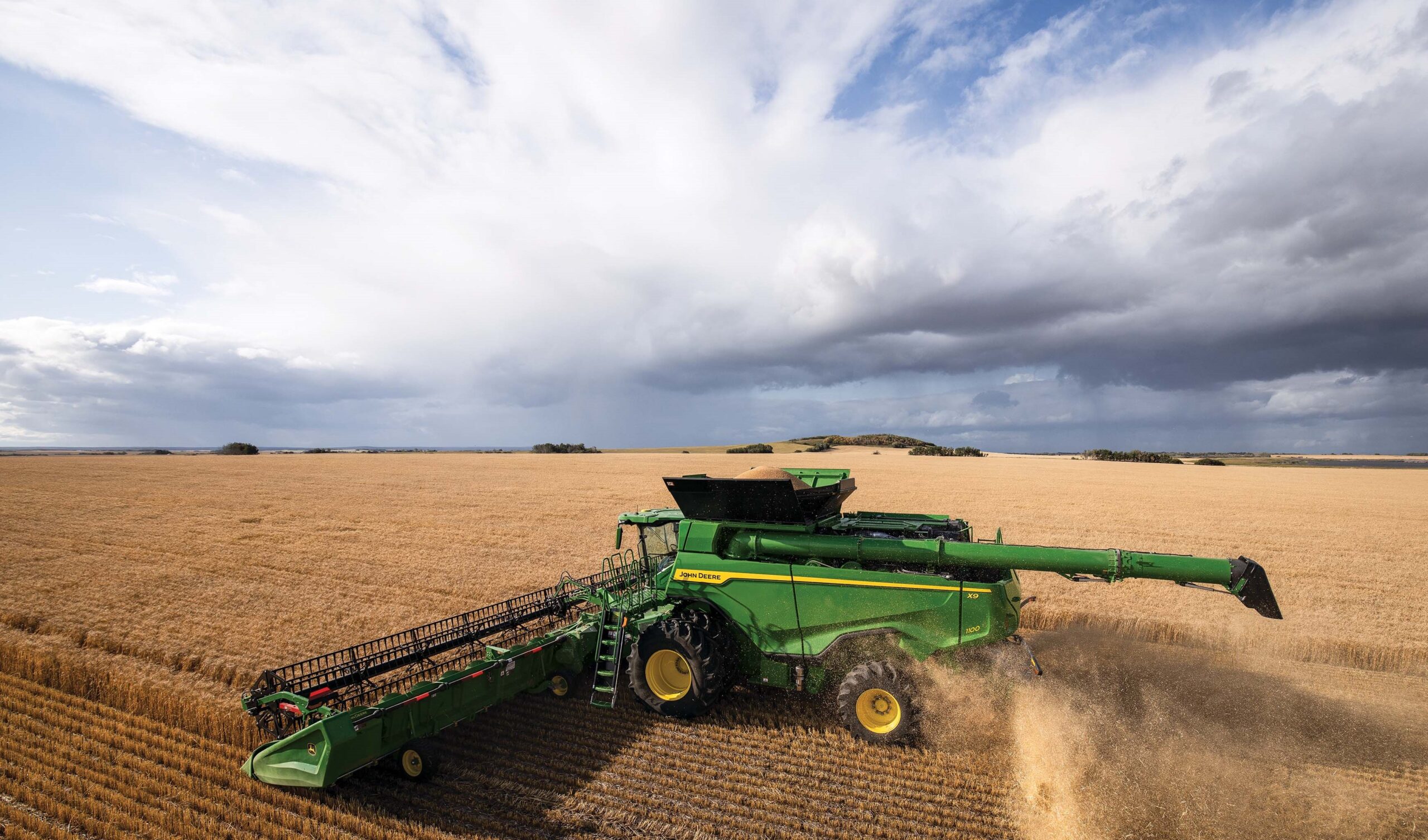Make your combine the ideal residue manager
John Deere combine spreads the full width of this 50-foot header.
Not every combine is created equal when it comes to residue spread. If uniform spreading is an important farm objective, make this a “must have” feature for your next combine purchase. Adam Gurr did.
With a farm system based on no-till and controlled-traffic farming “residue management is huge for us,” says the farmer from Rapid City, Manitoba. “With controlled traffic farming, if you don’t spread residue the full header width, it affects concentration of nutrients, seed placement and uniform emergence.”
Gurr has his sprayer, seeding tool and combine in 40-foot increments to keep all wheels running on the same tracks. That means a 40-foot combine header. That width might sound like a challenge for uniform residue management in a no-till system, but Gurr buys combines with that challenge in mind. In 2022, he bought a Lexion 8700 with 40.5’ header (to provide a little extra width to limit misses) and a ProChop chopper. The combine has sensors at the back end that automatically adjust the power spreader to achieve uniform and full-width distribution on slopes or in a crosswind. Gurr says the chopper has “no problem with the 40-foot header width.”
His other combine is a Lexion 760 with TurboChop chopper. “It does a good job at 40 feet in a normal wind,” Gurr says.
This two-machine combination is a step change improvement in residue management for the farm. “I don’t feel like we need to harrow anymore,” Gurr says. The older combine he sold to get the 8700 wasn’t as good, so they usually heavy harrowed each field.
Jason Casselman hopes for big improvements on his farm this harvest. The Canola Council of Canada agronomy specialist also has a small farm near Grande Prairie, Alberta, and he acquired a new quarter over the winter. The previous owner’s combines left strips of heavy chaff. “Long straw went through the chopper and was spread, but chaff and smaller material seemed to be dropping on the ground and being laid down in a bit of a windrow,” Casselman says.
For canola seeding this spring, Casselman found these chaff windrows particularly challenging in higher-yielding parts of the field where residue was heaviest. Openers on Casselman’s seeding tool – a Lemken disc drill – didn’t penetrate through the heavy chaff. Plants from canola that went 1/4” to 1/2” into the soil all looked good, he says, while seeds trapped in the residue germinated much later, after a rain, and only some of them took root. Canola crop staging was highly variable, with large plants beside tiny plants. Casselman admits he could have done a better job of seeding, getting out to check on seed placement in those heavy residue areas. “But the better step, ultimately, would be proper residue spread with the combine,” he says.

A combine that can achieve a uniform layer of residue could eliminate the need for any further field operations to manage residue. If displeased with the results during routine harvest assessments, here are a few relatively small changes that could improve the width and uniformity of residue spread:
• Vanes or powered tailboard. Change the angle of vanes or, for combines with this feature, speed up or slow down the disks on the power tailboard.
Chopper knives. Sharpen or flip chopper knives and blades, and replace knives as needed.
• Chopper speed. Higher speeds may be necessary in heavy stubble or with wide headers. Chopper speed is crop dependent; adjustments are often necessary to suit the particular crop.
• Chaff spreader. Adjust as needed to get chaff spread as wide and thin as possible. For many combine models, choppers spread both straw and chaff.
• Combining conditions. Straw conditions will influence chopping and spreading. Tough straw can lead to a residue situation that is extremely difficult to remedy.
• Cut height. Taller stubble means less material through the combine, which leaves less to spread over the soil surface. Ideally, find a cut height that is tall enough to improve residue spreader performance but not too tall as to affect residue flow through the seeding tool.
On height, the recommendation has been to cut stubble at a height equal to or less than the seeding tool’s row spacing. If row spacing is 12” (30cm), cut stubble at 12” or less. Gurr cuts wheat at 8” to 12” and canola at 18” or more. The seed row width on his drill is 12”. Gurr had followed the old no-till recommendation to match stubble height to row spacing, but “that is not as important anymore,” he says, because they now use accurate guidance to seed between the stubble rows. This greatly reduces the risk of stubble bunching up in the seeding tool, he says.
For more on residue management, including research citations on stubble height, harrowing and tillage, please read “Manage residue with the combine alone” in the Harvest section at canolawatch.org/fundamentals.





